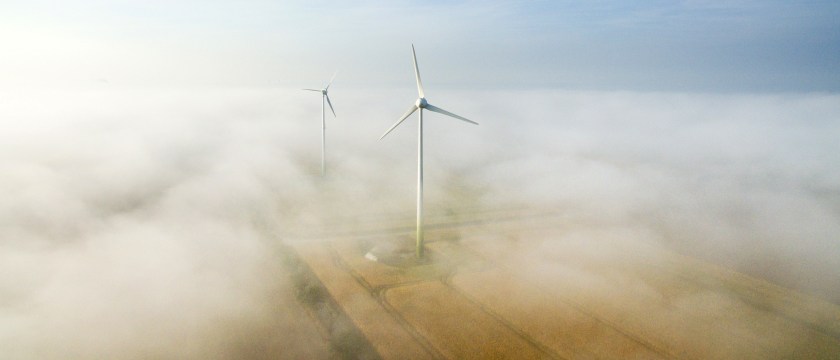...But not like this.
What you see in the discussion here of making ordinary blade turbines bigger (from the linked article below from Mach) is a recitation of the physical limits of blades that make it difficult to scale such turbines up. Which is, of course, precisely why traditional blades remain within the category of low power density types of generation.
And the main problem here is really a quite simple one: the fact that the blades themselves are both the inclined plane, surface collection area, in which to translate the contact of wind force into shaft torque, as well as the the force translator itself. In effect having the wind to surface contact area having to spin around with the the shaft to the generator, which generates (all puns intended) all sorts of vibration, and flexing problems for propellor blades big enough to collect a significant portion of the wind that blows past them.
This difficulty has been eliminated with the genius of the Yen Tornado Turbine. In this design, the process of collecting the wind, as opposed to translating that wind force into shaft torque, is separated. Collection is done by having an immense vertical column get wind inputs into it from whatever direction, and vertical height. The original idea that Dr. Yen had was to have, say spring loaded doors, around the entire vertical circumference of the collecting column; doors that would easily allow the wind in, but not let it out (at least from the column walls). With such inputs coming in, and the preservation of the angular momentum turning the interior circulation into a cyclonic like spin, you then create a tremendous pressure differential at a base, center throat; a narrowing channel into which multi stage, turbine fan rotors, much like a jet engine, can be placed, to do the actual translation of wind to shaft energy.
As the years have progressed, and I have thought more about this design, it has occurred to me that the many input door approach might not actually be the best way to do this. And I say that for two main reasons. First, all of those doors represent a potential, very big maintenance issue. And secondly, as I recall the original proof of concept design they used in their wind tunnel study (originally reported by Aviation Week & Space Technology, back in the seventies), there were no doors used at all. What they had then was simply a vertical slit, going up one side of the column to allow the wind in (much like an elongated conch shell). As such, you might be able to simplify the entire huge structure by creating four such slits, at each compass point, that just wrap around, and underneath, the next slit, at the next compass point, tapering the interior, exit slits depth, down to some optimum for the best preservation of laminar flow once the air comes into the column's interior.
The tradeoff here, of course, is that you limit some of the inherent flexibility that the doors gave you in being able to collect wind from all directions; something that I think might be ameliorated significantly simply by utilizing the red sails you see in my Tornado Turbine model. The idea there was to use such sails, suspended from tracks that would allow the sails free movement around the column, to snatch up as much wind as possible from beyond the nominal circumference of the column. Angle these properly and I think most of the wind outside of a compass point input slit, could still be captured. But this, of course, would all have to be a part of the overall R&D to finalize a production design.
In any case, though, scaling up a Tornado Turbine column, to very large sizes, is child's play compared to doing the same for traditional blade turbines. Which is why the model I constructed would be capable of generating nuke plant levels of power. And the even better part here is that the incredible amounts of waste heat that are created when both electrolyzing water, and then cooling the hydrogen gas to a liquid, would be easily recaptured by radiating it inside the column itself (Dr. Yen originally wanted to build these near coal seams so that coal plant waste heat could be used) to encourage the updrafts necessary to amplify your translation throat air flow.
To be sure, though, this is still not trivial engineering we're talking about here as the column my model tries to illustrate is something like a thousand feet tall, and over 3 hundred feet in diameter. And since the best place to put them is out at sea in the first place, (where wind and water are abundant), making such a structure seaworthy is no small task at all; and why the thing is built as a kind of radial A-frame structure, as well as why the outrigger arms, for the guy wiring, had to be so substantial.
The bottom line here is that the Yen Tornado Turbine would be a big part of the answer of how solar energy can go prime time, and how it can put the world into an effective hydrogen energy economy. Even though the idea is now decades old, it still has tremendous merit, and one cannot imagine why we wouldn't want to use it.



No comments:
Post a Comment